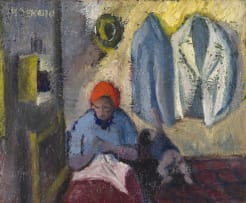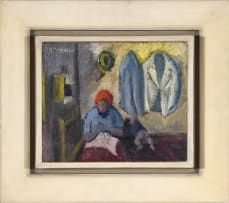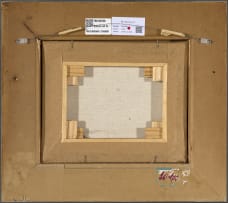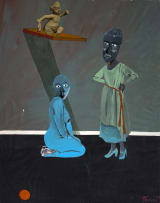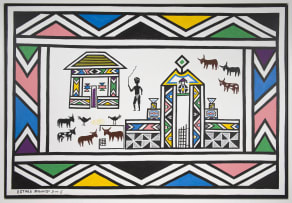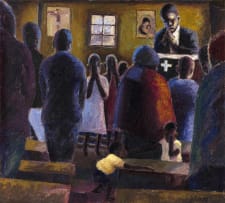Mother and Baby
Gerard Sekoto
About the SessionCuratorial Voices: Modern and Contemporary Art from Africa is a dynamic collaborative project conceived by Strauss & Co to address the need for diversified representation of artists from across the African continent in the secondary market. Curated by Strauss & Co Heads of Sale, Kirsty Colledge and Kate Fellens, with input by seven international art experts with embedded knowledge of Africa; Serge Tiroche, Valerie Kabov, Heba Elkayal, Danda Jaroljmek, Anne Kariuki, Dana Endundo Ferreira, Kimberley Cunningham. Curatorial Voices presents collectors with a broad selection of work by leading contemporary artists alongside select pieces by important historical artists.
Incl. Buyer's Premium & VAT
About this Item
signed
Notes
"Art is a human virtue and I have given my whole self to it, for it promotes understanding among races rather than destroys it."-Gerard Sekoto
Two months before his departure to Europe the present lot was exhibited at the Gainsborough Galleries. An important exhibition for Sekoto, who had already decided to leave for Paris, to follow his dream of living in the art capital of the world, amongst the post-impressionists who inspired his work. The exhibition was intended to raise money so that he could go. Two months later he painted the famous Self Portrait (1947) on the ship sailing towards his new home. He never returned to South Africa.
Interestingly Prayer in Church is one of only a few works portraying a religious scene by the artist. Seemingly the only recorded interior of a Church. Sekoto, as well as his parents, were born on a Christian mission station thereby prohibiting any exposure to traditional spiritual belief systems. Christian faith and its modernising imperatives played an important role in Sekoto's early life, as well as intellectually framed his cosmopolitan depiction of black urban life. Yet, Sekoto's strict Christian upbringing did not result in a life devoted to the church or its beliefs, but rather in a philosophy which Chabani Manganyi describes as having turned his pursuit of art into a kind of personal worldly religion.1
The reference to his religious upbringing in the present lot possibly reads a memory of this childhood. More importantly, it unearths a crucial problematic by-product of colonisation in South Africa -the long term cultural influence and impact that Christian missionaries had on the native population of Africa.
Similar to masterpieces like Sixpence a Door (1946) and Song of the Pick (1946), the vantage adopted in lot 79 is snapshot-like. Sekoto is at once a removed observer and an engaged participant. His church scene showcases his flair for distilling the essentials of an encounter: the formal attire of congregants, their separation by gender and age, the devotion of the priest and adolescents flanking him, the church's modest furnishings and décor, the bored toddlers at play.
A similar attentiveness to the particulars of domestic life is evident in lot 80. This intimate interiorstudy, notable for its liquid blues, shock of orange, and feathery brushwork, wonderfully adapts and complicates a familiar trope of religious painting, the mother and child study. Sekoto diligently itemizes the wardrobe of the absent father, whose jacket is the subject of fascination and supplication by the partially clothed babe.
Gerard Sekoto is recognised as a pioneer of black South African modernism. He was born at Botshabelo Lutheran mission station in Mpumalanga in 1913 and studied at Grace Dieu, an Anglican training college for black school teachers. He worked as a teacher until 1939 when he moved to Johannesburg to pursue a career as an artist. He was part of a small cohort of black artists who achieved prominence in the interwar years, before the start of high apartheid in 1948. Sekoto lived in the vibrant multiracial communities of Sophiatown and District Six and the rich colour of his paintings from these times capture the reality of living with sensitivity, dignity, and a sense of calmness despite the harsh realities of life under apartheid. Lot 79 derives from the period he spent in Eastwood, a settlement on the eastern municipal boundary of Pretoria, between 1945 and 1947. Paintings from this brief period represent the high point of his artistic career and are highly collectable. His aptitude for colour, form, mood, and movement all cohered into a compelling unity during this period.2 Sekoto lodged with his mother and stepfather in Eastwood (his father, Andreas, died in 1938). Already attuned to describing aspects of black urban life from his sojourns in Sophiatown and District Six, Sekoto concentrated on scenes of collective labour, reverie, and domesticity, less so religious ceremony. Sekoto went into self-imposed exile in Paris in 1947 where he worked as an artist and musician until his death in 1993. He was designated a Chevalier des Arts et des Lettres by the French government and posthumously received the Order of Ikhamanga for achievement in the arts from the South African government.
1. Chabani Manganyi (2004) Gerard Sekoto: 'I am African', Johannesburg: Wits University Press.
2. Lesley Spiro (1989), Gerard Sekoto: Unsevered Ties. Johannesburg, Johannesburg Art Gallery, page 41.
Provenance
Mrs F Losman.
Johans Borman Fine Art Gallery, Cape Town, 2001.
Private Collection.
Exhibited
Wits Art Museum, Johannesburg, Song for Sekoto: Gerard Sekoto 1913-2013, 25 April to 2 June 2013, illustrated in the exhibition catalogue on page 149 with the title 'Mother with Baby'.
Literature
Barbara Lindop (1988) Gerard Sekoto, Randburg: Dictum Publishing, illustrated in colour on page 138 to 139.

